Experimental Evaluation of a Switching Matrix Applied in a Bank of Supercapacitors
Abstract
:1. Introduction
2. Switching Matrix
3. Operation Principle Analysis
4. Experimental Results
5. Conclusions
Acknowledgments
Author Contributions
Conflicts of Interest
References
- Blaabjerg, F.; Yang, Y.; Yang, D.; Wang, X. Distributed Power-Generation Systems and Protection. Proc. IEEE 2017, 105, 1311–1331. [Google Scholar] [CrossRef]
- Wu, T.-F.; Chang, C.-H.; Lin, L.-C.; Kuo, C.-L. Power Loss Comparison of Single- and Two-Stage Grid-Connected Photovoltaic Systems. IEEE Trans. Energy Convers. 2011, 26, 707–715. [Google Scholar] [CrossRef]
- Abdelkafi, A.; Krichen, L. Energy management optimization of a hybrid power production unit based renewable energies. Int. J. Electr. Power Energy Syst. 2014, 62, 1–9. [Google Scholar] [CrossRef]
- Li, L.; Huang, Z.; Li, H.; Peng, J. A rapid cell voltage balancing scheme for supercapacitor based energy storage systems for urban rail vehicles. Electr. Power Syst. Res. 2017, 142, 329–340. [Google Scholar] [CrossRef]
- Nie, J.-F.; Xiao, X.; Nie, Z.; Tian, P.; Ding, R. A novel three-level changeover circuit of super-capacitor bank for energy storage systems. In Proceedings of the 38th Annual Conference on IEEE Industrial Electronics Society (IECON 2012), Montreal, QC, Canada, 25–28 October 2012; pp. 144–149. [Google Scholar]
- Sathishkumar, P.; Piao, S.; Khan, M.; Kim, D.-H.; Kim, M.-S.; Jeong, D.-K.; Lee, C.; Kim, H.-J. A Blended SPS-ESPS Control DAB-IBDC Converter for a Standalone Solar Power System. Energies 2017, 10, 1431. [Google Scholar] [CrossRef]
- Liu, J.; Zhang, L. Strategy Design of Hybrid Energy Storage System for Smoothing Wind Power Fluctuations. Energies 2016, 9, 991. [Google Scholar] [CrossRef]
- Ibanez, F.M.; Echeverria, J.M.; Vadillo, J.; Fontan, L. A Step-Up Bidirectional Series Resonant DC/DC Converter Using a Continuous Current Mode. IEEE Trans. Power Electron. 2015, 30, 1393–1402. [Google Scholar] [CrossRef]
- Azib, T.; Bethoux, O.; Remy, G.; Marchand, C.; Berthelot, E. An innovative control strategy of a single converter for hybrid fuel cell/supercapacitor power source. IEEE Trans. Ind. Electron. 2010, 57, 4024–4031. [Google Scholar] [CrossRef]
- Uno, M.; Tanaka, K. Single-switch single-inductor equalization charger using a voltage multiplier for series-connected energy storage modules. In Proceedings of the 2011 IEEE 8th International Conference on Power Electronics and ECCE Asia (ICPE & ECCE), Jeju, Korea, 30 May–3 June 2011; pp. 2985–2989. [Google Scholar] [CrossRef]
- Zhang, E.; Qi, Z.; Wei, T. Research on combination of series and parallel with supercapacitor module. In Proceedings of the 2010 2nd IEEE International Symposium on Power Electronics for Distributed Generation Systems (PEDG), Hefei, China, 16–18 June 2010; pp. 685–690. [Google Scholar] [CrossRef]
- Srithorn, P.; Aten, M.; Parashar, R. Series connection of supercapacitor modules for energy storage. In Proceedings of the 3rd IET International Conference on Power Electronics, Machines and Drives (PEMD 2006), Dublin, Ireland, 4–6 April 2006; Volume 2006, pp. 354–360. [Google Scholar]
- Chatzakis, J.; Kalaitzakis, K.; Voulgaris, N.C.; Manias, S.N. Designing a new generalized battery management system. IEEE Trans. Ind. Electron. 2003, 50, 990–999. [Google Scholar] [CrossRef]
- Yuhimenko, V.; Averbukh, M.; Agranovich, G.; Kuperman, A. Dynamics of supercapacitor bank with uncontrolled active balancer for engine starting. Energy Convers. Manag. 2014, 88, 106–112. [Google Scholar] [CrossRef]
- Jaysree, K.S.; Ezhilarasan, G.; Monish, K.; Arundhilipan, V.; Sumalatha, G. Battery Less Power Conditioner Using a Super Capacitor. Int. J. Sci. Eng. Res. 2014, 5, 214–218. [Google Scholar]
- Uno, M.; Toyota, H. Supercapacitor-based energy storage system with voltage equalizers and selective taps. In Proceedings of the PESC Record—IEEE Annual Power Electronics Specialists Conference, Rhodes, Greece, 15–19 June 2008; pp. 755–760. [Google Scholar]
- Uno, M. Series-parallel reconfiguration technique for supercapacitor eneryg storage systems. In Proceedings of the TENCON 2009—2009 IEEE Region 10 Conference, Singapore, 23–26 January 2009; pp. 2–6. [Google Scholar] [CrossRef]
- Yu, D.; Liu, H.; Yan, G.; Jiang, J.; Blond, S. Le Optimization of Hybrid Energy Storage Systems at the Building Level with Combined Heat and Power Generation. Energies 2017, 10, 606. [Google Scholar] [CrossRef]
- Odeim, F.; Roes, J.; Heinzel, A. Power management optimization of an experimental fuel cell/battery/supercapacitor hybrid system. Energies 2015, 8, 6302–6327. [Google Scholar] [CrossRef]
- Kollimalla, S.K.; Mishra, M.K.; Narasamma, N.L. Design and analysis of novel control strategy for battery and supercapacitor storage system. IEEE Trans. Sustain. Energy 2014, 5, 1137–1144. [Google Scholar] [CrossRef]
- Ye, Y.; Cheng, K.W.E. Modeling and Analysis of Series-Parallel Switched-Capacitor Voltage Equalizer for Battery/Supercapacitor Strings. IEEE J. Emerg. Sel. Top. Power Electron. 2015, 3, 977–983. [Google Scholar] [CrossRef]
- Sano, K.; Fujita, H. A resonant switched-capacitor converter for voltage balancing of series-connected capacitors. In Proceedings of the International Conference on Power Electronics and Drive Systems (PEDS 2009), Taipei, Taiwan, 2–5 November 2009; pp. 683–688. [Google Scholar] [CrossRef]
- Sugimoto, S.; Ogawa, S.; Katsukawa, H.; Mizutani, H.; Okamura, M. A Study of Series-Parallel Changeover Circuit of a Capacitor Bank for an Energy Storage System Utilizing Electric Double-Layer Capacitors. Electr. Eng. Jpn. 2003, 145, 33–42. [Google Scholar] [CrossRef]
- Somayajula, D.; Crow, M.L. An integrated active power filter-ultracapacitor design to provide intermittency smoothing and reactive power support to the distribution grid. IEEE Trans. Sustain. Energy 2014, 5, 1116–1125. [Google Scholar] [CrossRef]
- Somayajula, D.; Crow, M.L. An Integrated Dynamic Voltage Restorer-Ultracapacitor Design for Improving Power Quality of the Distribution Grid. IEEE Trans. Sustain. Energy 2015, 6, 616–624. [Google Scholar] [CrossRef]
- Kamala, J.; Umamaheswari, B. Reconfigurable smart controller and interface architecture for Photo-voltaic Energy Storage System. Comput. Stand. Interfaces 2016, 46, 37–45. [Google Scholar] [CrossRef]
- Espinosa-Trujillo, M.J.; Flota-Bañuelos, M.; Pacheco-Catalán, D.; Smit, M.A.; Verde-Gómez, Y. A novel stand-alone mobile photovoltaic/wind turbine/ultracapacitor/battery bank hybrid power system. J. Renew. Sustain. Energy 2015, 7, 23125. [Google Scholar] [CrossRef]
- Fang, X.; Kutkut, N.; Shen, J.; Batarseh, I. Analysis of generalized parallel-series ultracapacitor shift circuits for energy storage systems. Renew. Energy 2011, 36, 2599–2604. [Google Scholar] [CrossRef]
- Fuller, J.F.; Roesler, D.J. Influence of harmonics on power distribution system protection. IEEE Trans. Power Deliv. 1988, 3, 549–557. [Google Scholar] [CrossRef]
- Xiao, X.; Nie, J.-F.; Nie, Z.; Tian, P.; Ding, R. A universal two-level changeover circuit of super-capacitor bank for energy storage systems. In Proceedings of the IECON 2012—38th Annual Conference on IEEE Industrial Electronics Society, Montreal, QC, Canada, 25–28 October 2012; pp. 180–184. [Google Scholar]
- Lu, R.; Zhu, C.; Tian, L.; Wang, Q. Super-Capacitor Stacks Management System With Dynamic Equalization Techniques. IEEE Trans. Magn. 2007, 43, 254–258. [Google Scholar] [CrossRef]
- Uno, M.; Toyota, H. Energy storage system based on supercapacitors with an unregulated DC-DC converter and selective intermediate taps. In Proceedings of the IEEE International Conference on Sustainable Energy Technologies (ICSET 2008), Singapore, 24–27 November 2008; pp. 713–716. [Google Scholar] [CrossRef]
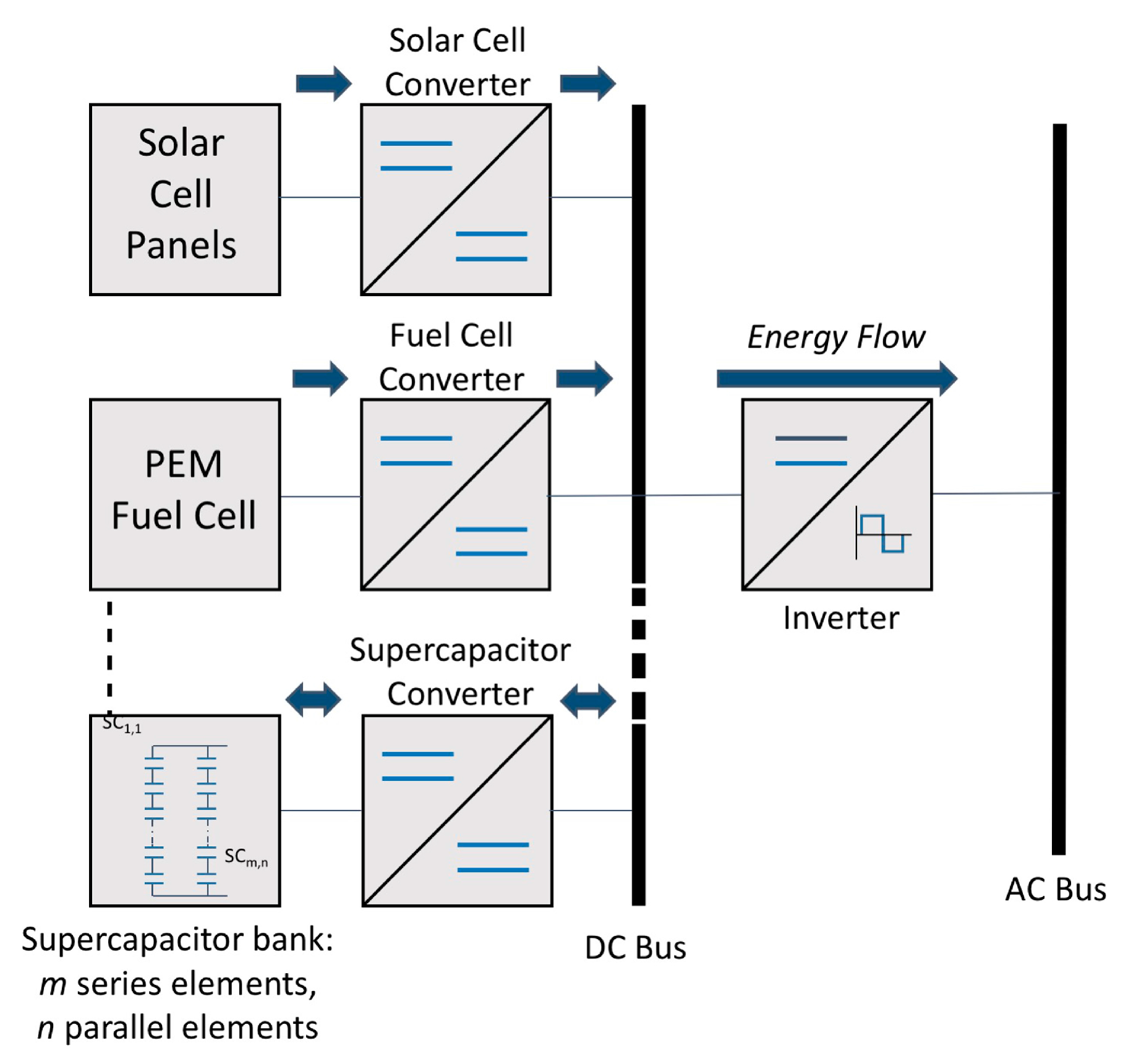
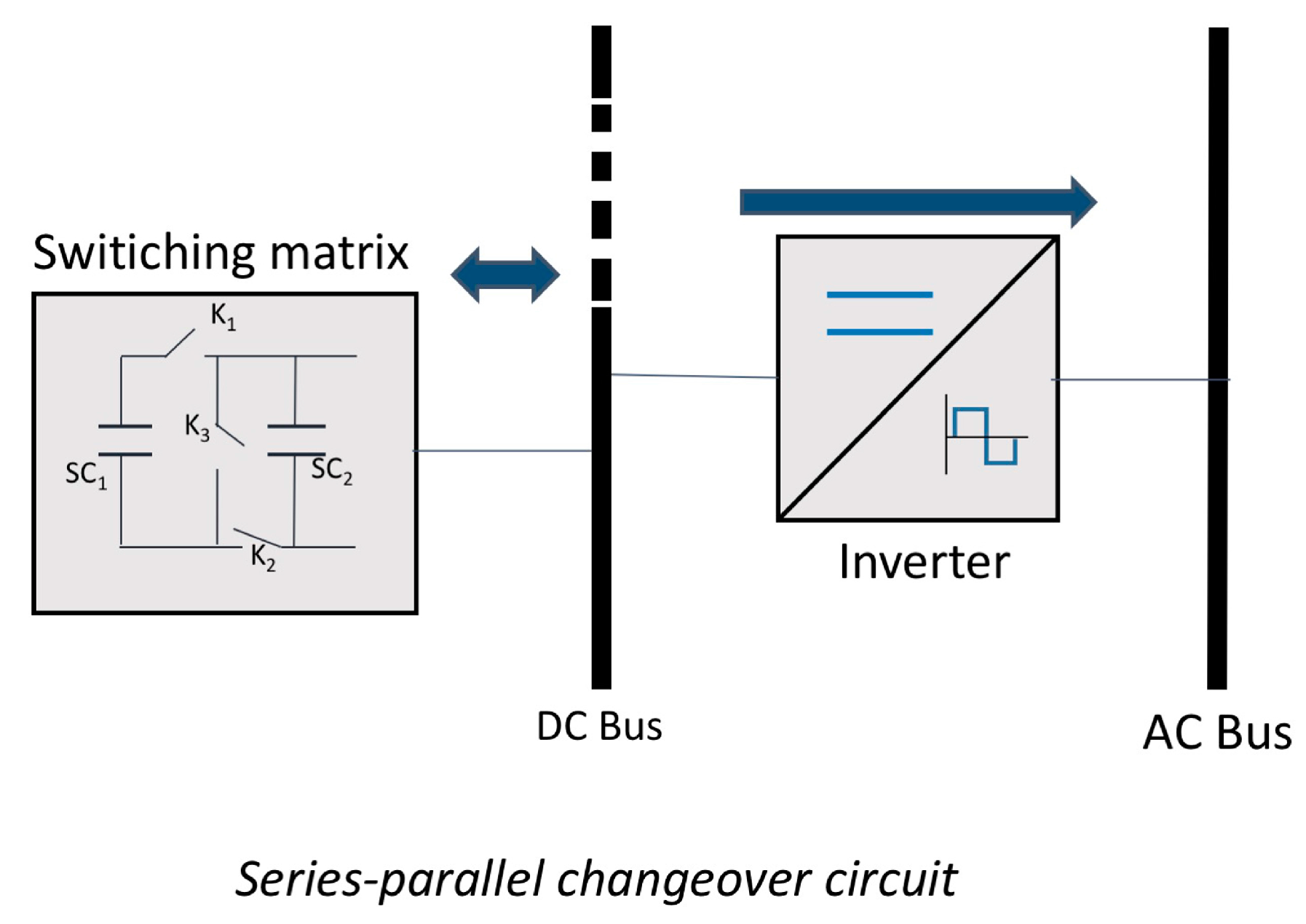

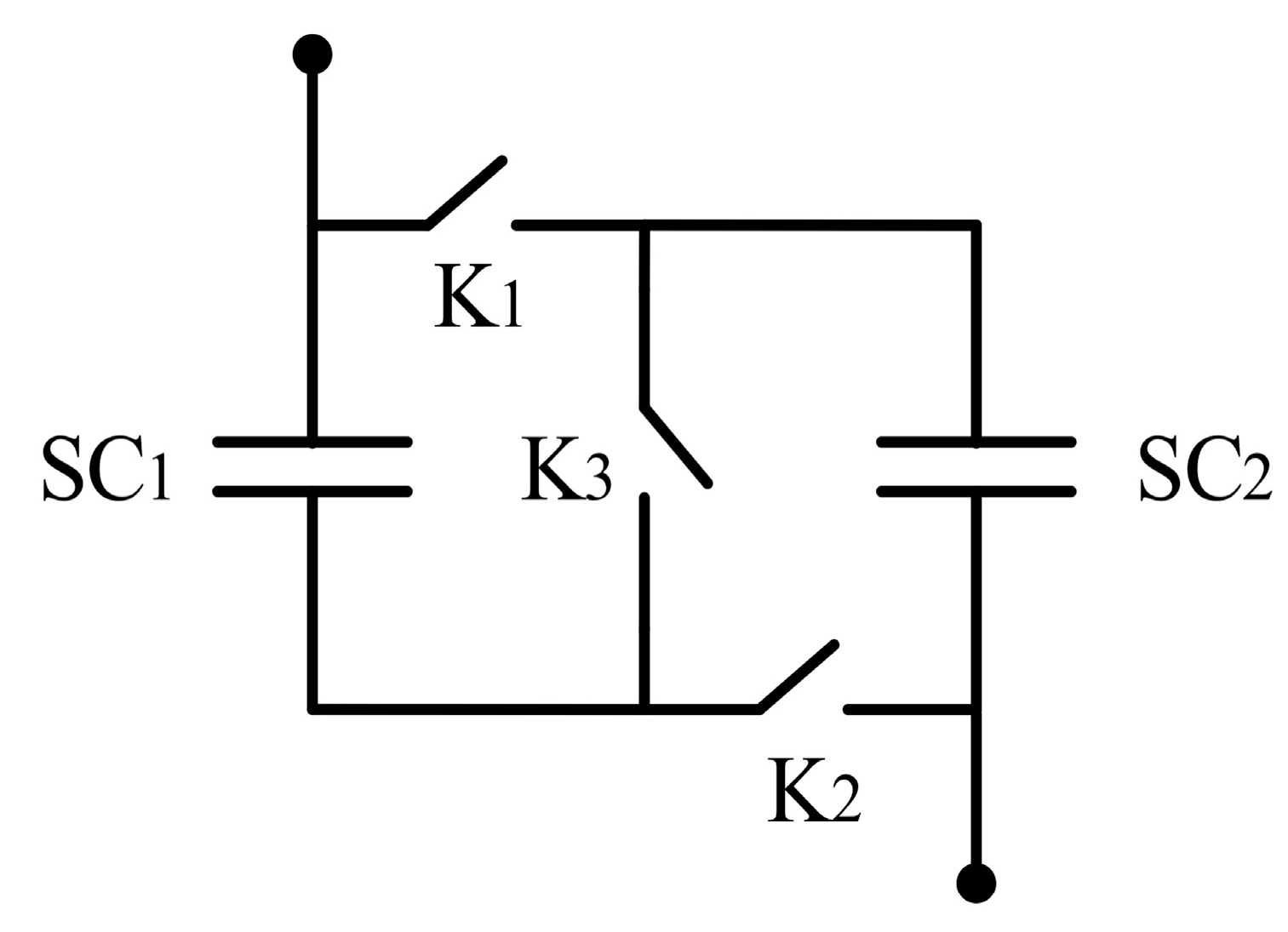
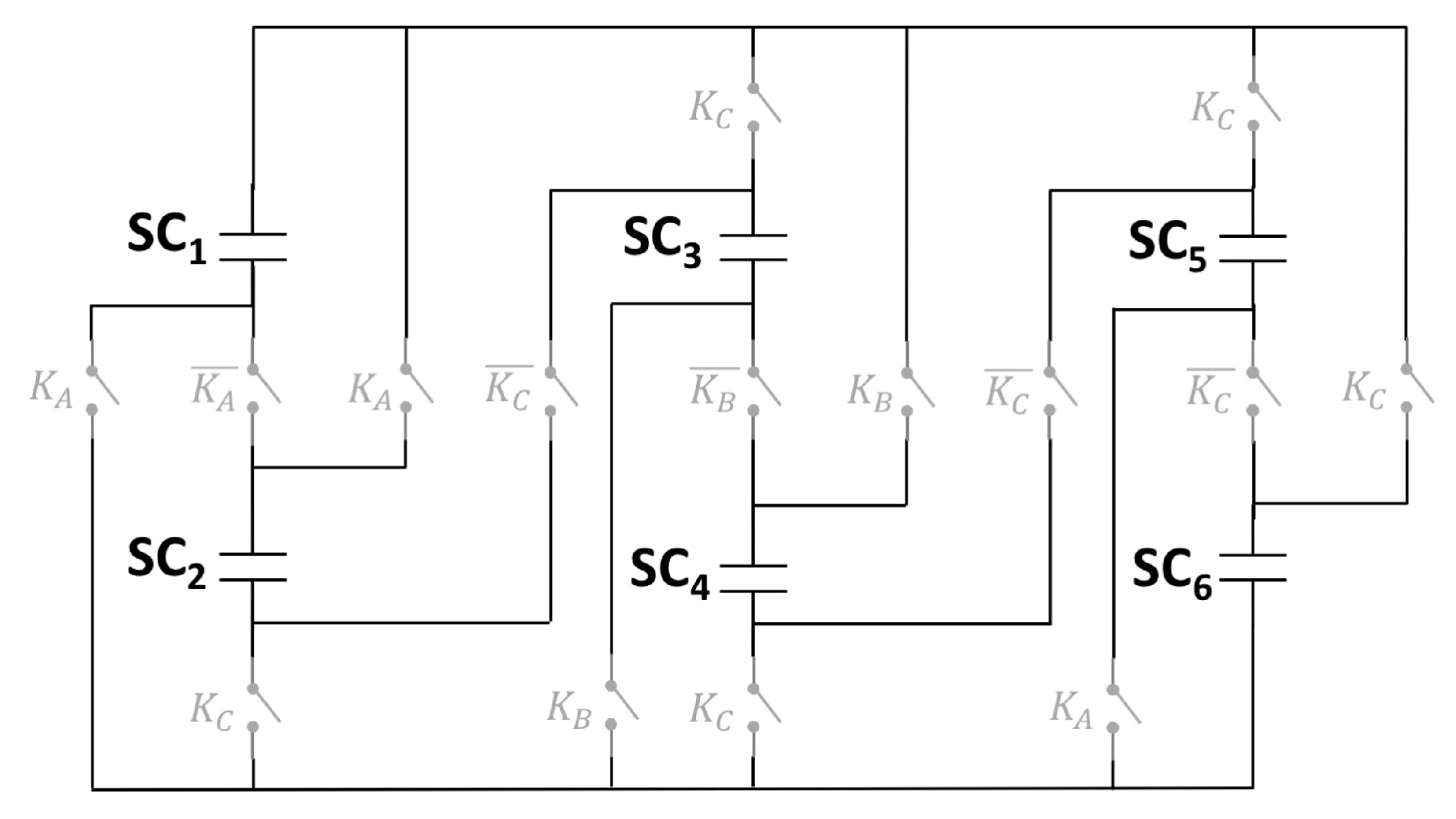
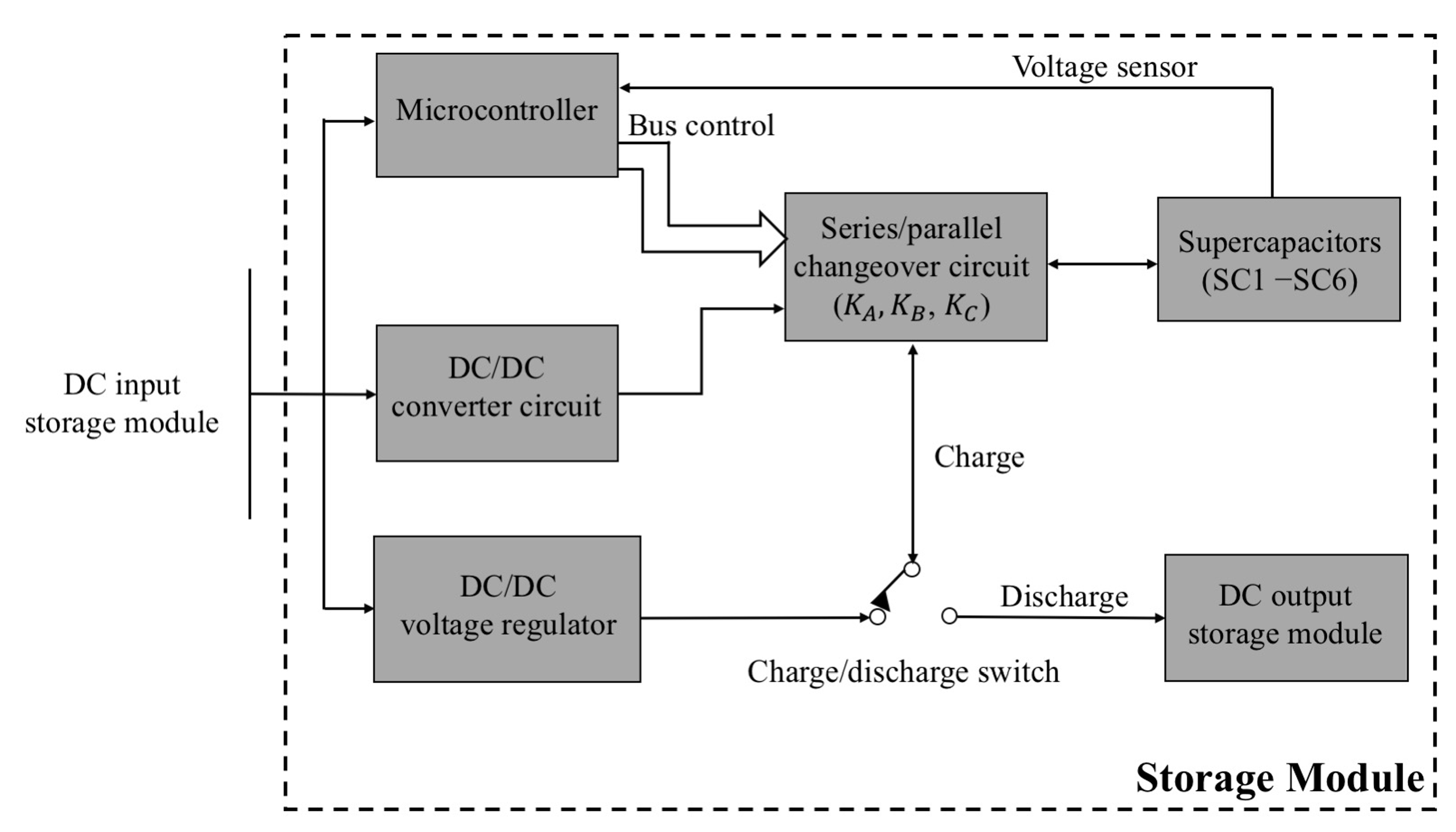
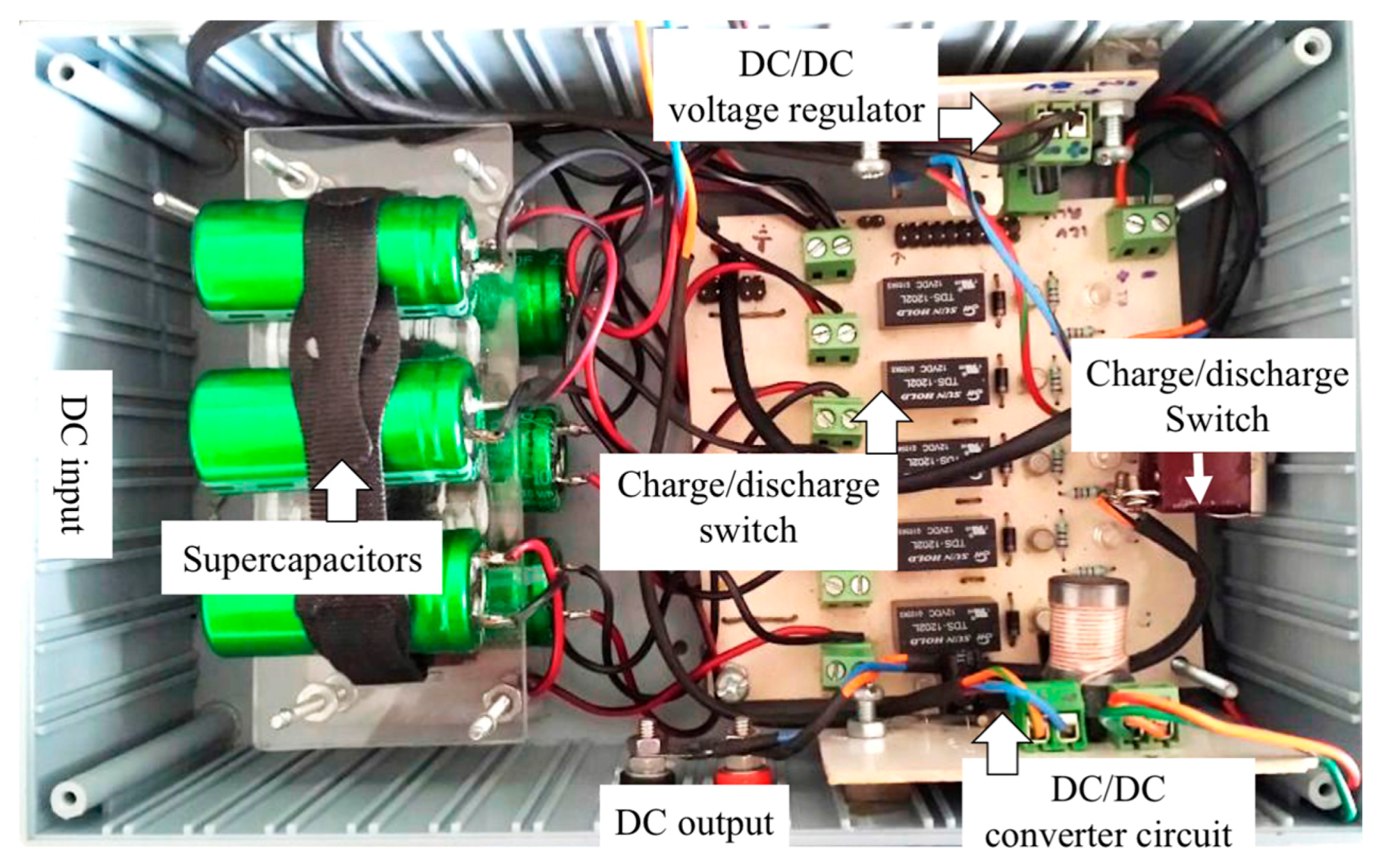
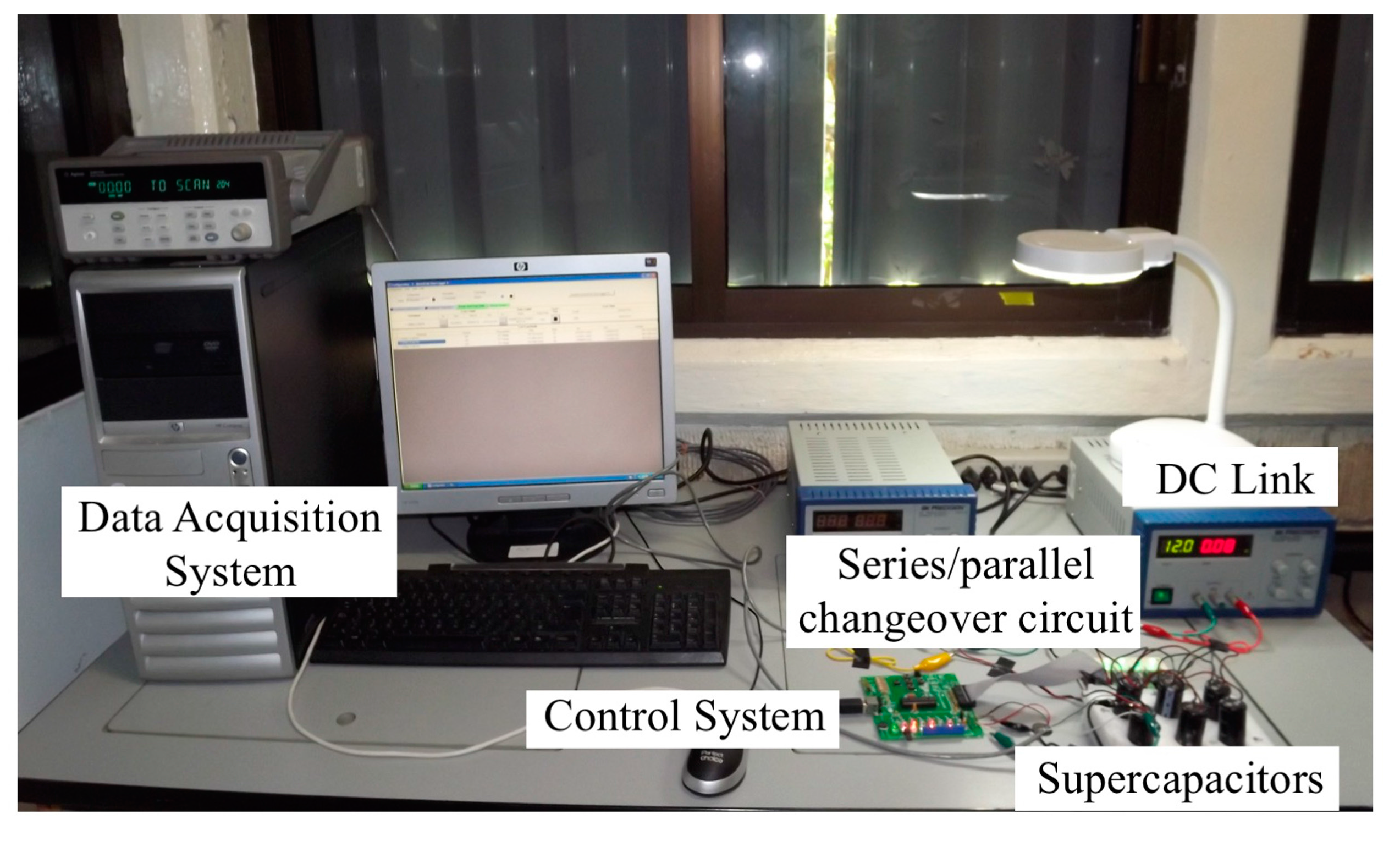


| Levels/Programmed States | Supercapacitor Electric Circuit | |
|---|---|---|
| (a) | VR1 111111 |  |
| (b) | VR2 010101 | 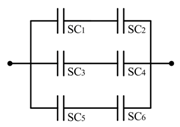 |
| (c) | VR3 001001 |  |
| (d) | VR4 000000 |  |
| Level | Limit Variable | Limit 0.6 V | Limit 0.7 V | Limit 0.8 V |
|---|---|---|---|---|
| 0.50 | 0.60 | 0.70 | 0.80 | |
| 0.33 | 0.30 | 0.35 | 0.40 | |
| 0.16 | 0.20 | 0.23 | 0.26 | |
| 0.10 | 0.10 | 0.11 | 0.13 |
| Routines | Time Increment (s) | Time Increment (%) |
|---|---|---|
| Limit variable () | 253 | 22.06 |
| Limit 0.6 V () | 287 | 30.93 |
| Limit 0.7 V () | 281 | 38.13 |
| Limit 0.8 V () | 272 | 49.10 |
| Routines | (Wh) | (Wh) | (Wh) | (%) |
|---|---|---|---|---|
| Limit variable () | 0.0903 | 0.0010 | 0.0891 | 99.75 |
| Limit 0.6 V () | 0.0883 | 0.0014 | 0.0866 | 99.65 |
| Limit 0.7 V () | 0.0930 | 0.0019 | 0.0907 | 99.56 |
| Limit 0.8 V () | 0.0910 | 0.0026 | 0.0877 | 99.20 |
© 2017 by the authors. Licensee MDPI, Basel, Switzerland. This article is an open access article distributed under the terms and conditions of the Creative Commons Attribution (CC BY) license (http://creativecommons.org/licenses/by/4.0/).
Share and Cite
Reveles-Miranda, M.G.; Flota-Bañuelos, M.I.; Chan-Puc, F.; Pacheco-Catalán, D. Experimental Evaluation of a Switching Matrix Applied in a Bank of Supercapacitors. Energies 2017, 10, 2077. https://doi.org/10.3390/en10122077
Reveles-Miranda MG, Flota-Bañuelos MI, Chan-Puc F, Pacheco-Catalán D. Experimental Evaluation of a Switching Matrix Applied in a Bank of Supercapacitors. Energies. 2017; 10(12):2077. https://doi.org/10.3390/en10122077
Chicago/Turabian StyleReveles-Miranda, Maria Guadalupe, Manuel Israel Flota-Bañuelos, Freddy Chan-Puc, and Daniella Pacheco-Catalán. 2017. "Experimental Evaluation of a Switching Matrix Applied in a Bank of Supercapacitors" Energies 10, no. 12: 2077. https://doi.org/10.3390/en10122077






